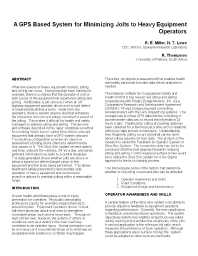Mining Publication: A GPS Based System for Minimizing Jolts to Heavy Equipment Operators
Original creation date: October 2004
When two pieces of heavy equipment interact, jolting and jarring can occur. During haulage truck loading for example, there is a chance that the operator of one or both pieces of the equipment will experience jolting and jarring. Additionally, a jolt can occur when an off highway equipment operator drives over a road defect or inadvertently strikes a berm. Aside from the operators, there is seldom anyone else that witnesses the interaction and can accurately describe the extent of the jolting. This makes it difficult for health and safety managers to address jolting and jarring. The devices and software described in this paper constitute a method for installing "black boxes" called Shox Boxes onboard equipment that already have a GPS system onboard. The resulting configuration provides an objective assessment of jolting and a chance to determine the root causes of it. The Shox Box system reviews data in real time, onboard the vehicles, 24 hrs a day, and sends pertinent information via radio to a central database. The data generated shows whether jolts are above or below a supervisor defined target value for the equipment and the tasks being performed. This allows health and safety personnel to demonstrate safe operation of heavy equipment and recommend proactive actions to maintain jolting within a reasonable range.
Authors: RE Miller, NT Lowe, R Thompson
Conference Paper - October 2004
NIOSHTIC2 Number: 20026127
SAE Commercial Vehicle Engineering Congress and Exhibition, October 26-28, 2004, Chicago, IL. Warrendale, PA: Society of Automotive Engineers International, 2004 Oct; :1-4
See Also
- Electromagnetic Noise in Itmann Mine
- Engineering Considerations and Selection Criteria for Proximity Warning Systems for Mining Operations
- A General Design and Implementation Procedure for Sensor-Based Electrical Diagnostic Systems for Mining Machinery
- Programmable Electronic Mining Systems: Best Practice Recommendations (In Nine Parts): Part 4: 3.0 Safety File
- Propagation of UHF Radio Waves in Limestone Room and Pillar Mines
- Radio 101: Operating Two-Way Radios Every Day and in Emergencies
- Research and Development Contract for Coal Mine Communication System: Volume 4 - Environmental Measurements
- Task Analysis
- Theory on the Propagation of UHF Radio Waves in Coal Mine Tunnels
- Torso Flexion Loads and Fatigue Failure Mode of Human Lumbosacral Motion Segments
- Page last reviewed: 9/21/2012
- Page last updated: 9/21/2012
- Content source: National Institute for Occupational Safety and Health, Mining Program


 ShareCompartir
ShareCompartir
